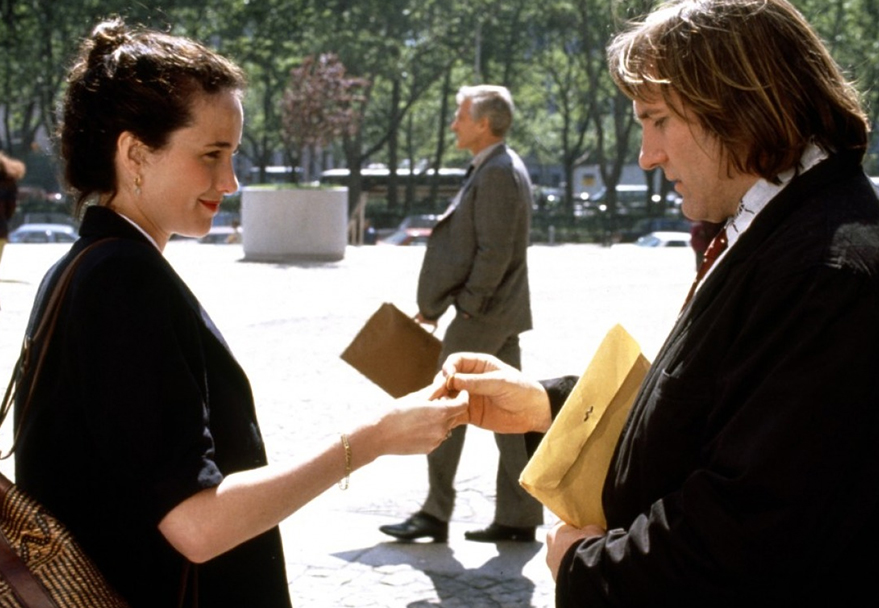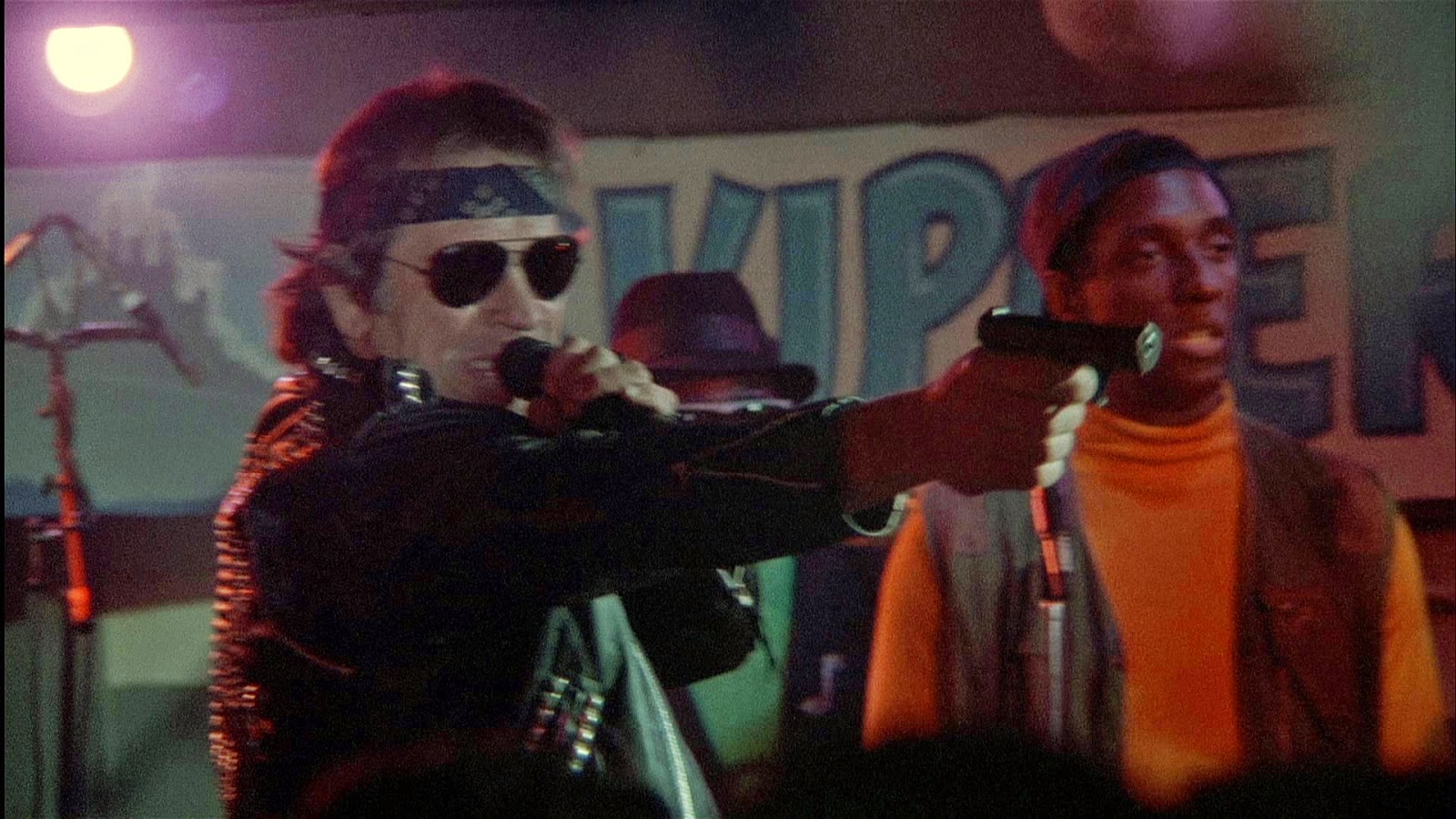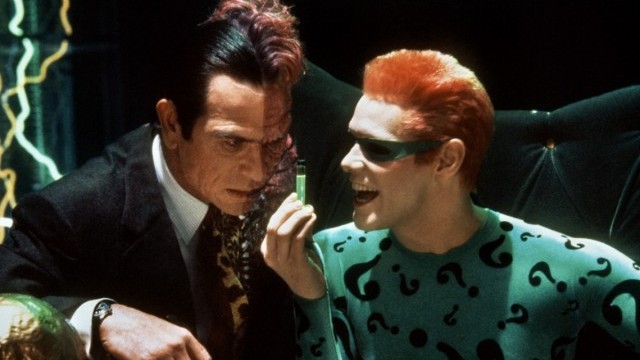6. Green Card, Best Original Screenplay

Comedies are famously underrepresented at the Academy Awards: only six comedies have ever won Best Picture, with the last being 1977’s Annie Hall. They fare only slightly better in the Best Original Screenplay category, with eight comedies having won since the category’s inclusion in 1940. While many comedy films have brilliant scripts, and comedy has the notorious reputation of being one of the most difficult genres to write in, it is still rarely favored by Academy voters. These factors are what make the nomination for the underwhelming 1991 romantic comedy Green Card such an anomaly.
The story of Green Card is simple farce: a Frenchman (Gerard Depardieu) enters a marriage of convenience with a woman (Andie MacDowell) so he can obtain a green card to the United States. But immigration agents conduct an inspection of their faux relationship and smell something fishy, so they demand a more extensive interview a few days later.
The Frenchman moves in and they try to get to know each other before their ruse is uncovered, which would lead to his deportation and her to face criminal charges. They clash as opposites, misunderstandings arise, and feelings for each other are discovered. The film ends on a lightly romantic note, and that’s the end of that bit of faff.
Intended as a vehicle to introduce Depardieu to English-speaking audiences, at best it was considered genial and at worst facile, but besides being a light romantic comedy there was not much either memorable or particularly interesting about the film. It was a modest success and served its purpose as a breezy way to pass an hour and forty minutes without much heavy lifting on the audience’s part. Written and directed by Peter Weir, who would go on to direct The Truman Show, the story was lifted from a little-known Quebecois TV movie, Les Noces de Papier (The Paper Marriage).
Surprisingly, this wisp of a movie was nominated for Best Original Screenplay for the 63rd Academy Awards. While it didn’t win (that honor went to Bruce Joel Rubin’s screenplay for Ghost), its nomination still seems surprising, considering the pedigree of its company in the category, including Whit Stillman’s debut Metropolitan, Barry Levinson’s Avalon, and Woody Allen’s Alice. Perhaps Academy members that year were running late in finishing their ballots and entered a choice of convenience of their own.
7. Under Siege, two nominations

Steven Segal’s Academy Award-nominated film Under Siege. That doesn’t sound right. But it’s true: America’s fifth favorite action star in the 1990s found his film, Under Siege, nominated for not one, but two, Oscars.
For those who haven’t seen the film, it involves a chief petty officer/cook (Segal) who thwarts an attempt by an unstable ex-CIA operative named Strannix (Tommy Lee Jones) that takes over an American battleship, planning to sell the missiles on board. But what he didn’t count on was Segal’s character also being an ex-Navy SEAL, and Segal spends the film punching and kicking his way through the bad guys and rescuing his shipmates. Like much of Segal’s cinematic oeuvre, it’s stupid, but he was out to make fun action movies for his audience, not win awards.
Except, for whatever reason, this film was nominated for two Academy Awards. Sure, they weren’t for acting or directing, but for technical awards: Best Sound and Best Sound Editing. Watching the film, you may not be able to detect exactly what was so spectacular about the sound that it would be considered Oscar-worthy, but then again, technical award nominations are often outside the ken of people outside of the business and can often be viewed as a way to honor former and future collaborators that have worked on dozens, if not hundreds, of films.
A bit of research into the sound team of Under Siege reveals that the people who worked on the film have worked on numerous projects before; certainly they had previously worked with many Awards voters, as well. At least it’s an interesting piece of trivia that this is the only Steven Segal film ever nominated for two Academy Awards (or any, for that matter).
8. Batman Forever, multiple nominations

Like most of the internet loves to do nearly constantly, let’s talk about Batman. An enduring character that first appeared in Detective Comics in 1939, in the ensuing 78 years Batman has become a cultural icon not only in America but the world over. But it’s silly to recap the history of Batman to anybody even remotely cognizant of culture: what we’re discussing here is the nosedive the initial film franchise of Batman took.
First started in 1989, it died a rightful death in 1997 with the atrocious Batman & Robin. Although remembered as one of the worst movies of all time, the film that preceded it–1995’s Batman Forever–just barely escaped the same condemnation only by being compared to its abysmal follow-up, which damns it by faint praise.
Make no mistake: Batman Forever is a terrible movie. It’s over-the-top, cartoonish, and overall ugly. The performances by all involved–including Val Kilmer’s distracted performance as Bruce Wayne/Batman–should have been career-killing. Featuring Jim Carrey as The Riddler and Tommy Lee Jones as Two-Face, both of their performances belong in the scenery-chewing hall of fame, while Chris O’Donnell–then a rising star–committed to the role of Robin, who came across as a petulant child rather than as a potential hero.
This film also marked the brief rise of portraying the franchise in a lighter, sillier tone akin to the original TV series. Bright primary colors, Dutch angles, wildly overblown villains, and more campy elements seeped into the Batman movies at this time, courtesy of director Joel Schulmaker, Although Batman Forever was financially successful and even spawned a hit soundtrack–complete with the gigantic hit “Kiss From A Rose” by Seal–in retrospect it has become a marker of the beginning of the end of the first attempt at making a franchise out of Batman.
This didn’t stop the Academy from nominating Batman Forever for three Academy Awards: two for the difficult-to-determine Best Sound Mixing and Best Sound Editing and one, surprisingly, for Best Cinematography.
Maybe it was because Batman Forever was the sixth highest-grossing film of the year, or perhaps 1995 was a confusing year in cinema in general (as an example of the weird atmosphere this year engendered, Babe–a picture about a talking pig–was nominated for Best Picture). Still, it’s surprising that the obvious choice for Best Original Song, “Kiss From A Rose,” was not nominated for an award. Maybe Carrey’s constant mugging distracted voters.
9. Sean Penn, Best Actor, I Am Sam

There’s a famous piece of acting advice in Ben Stiller’s Tropic Thunder provided by Robert Downey Jr’s character, who has immersed himself so deeply into his current role that he chemically changed the pigment of his skin to appear black: “Never go full retard.” Sean Penn’s performance in 2001s I Am Sam is used as an example of this concept by Downey’s character, and it is apt. Perhaps one of the more offensive performances ever committed to screen of a mentally challenged adult, Penn plays the titular Sam like an overgrown 6-year-old akin to Robin Williams’ performance in Jack.
Portraying mentally challenged adults in film is difficult–hence the essence of Downey’s joke in Tropic of Thunder–and it’s a fine line between playing a sympathetic character that overcomes the struggle of being differently abled to maintain their life and acting like a drooling simpleton who can barely articulate thoughts or have control over basic emotions. Penn’s performance in the risible I Am Sam, which details the life of a severely mentally challenged man attempting to retain custody of his young daughter, is firmly in the latter category.
The film itself is the sort of Oscar-bait that has been parodied many times since its premiere: A man with a developmental disability fathers a child with a homeless woman who uses him for a place to stay and then abandons him. After an incident where it is suggests that he cannot care for the child on his own, Sam enters a protracted legal battle to defend himself and prove that he can take care of her as an autonomous adult.
The idea of the film is a noble one that should tug at a viewer’s heartstrings; instead, Sean Penn goes “full r—-d,” in turn making his character obnoxious and planting a seed of doubt in the the audience’s mind as to whether the state has a good reason to retain custody of his child. In a brave but ultimately empty performance, Penn relays the more outre behavioral tics of a person with a severe mental disability without really showing the humanity of the character inside. Instead, it comes across on-screen as a caricature of what the mentally disabled seem like to Sean Penn.
Being an industry favorite, Penn nabbed a Best Actor nomination at the 74th Academy Awards, but against such strong competition, such as Denzel Washington in Training Day and Will Smith in Ali, Penn didn’t stand a chance and walked away empty-handed that night. In the years following its release, Penn’s performance has taken on a life of its own, memetically mutating via Tropic of Thunder as an example of why no actor should go full you-know-what in their performance, no matter how tempting and Oscar-worthy this risky endeavor may seem.
10. The Blind Side, Best Picture

Race relations in America is a minefield to navigate in film: for every Do The Right Thing that speaks truth to power, you have a Driving Miss Daisy that sanitizes the inherently unbalanced relationship between a rich white woman and her poor black driver. While it’s surprising that Driving Miss Daisy won Best Picture while Do The Right Thing wasn’t even nominated in that category (they both came out the same year), a lot has changed in America in the 20 years since the release of both pictures. Or have they? Case in point is 2009’s The Blind Side.
The film relates the true story of a wealthy Southern white woman (Sandra Bullock) who rescues an athletic, but emotionally damaged, young black man (Quinton Aaron) from his life of poverty and homelessness. Defying conventions and facing social ostracization, this woman summons the courage to help this young man from overcoming his own fears and the limitations life had put on him by adopting him and setting him on the right track in life.
In the end, he is recruited by a college football team. If that sounds like a flip summary of the movie, that’s because the narrative of the film firmly splits its focus between the supposed protagonist (the troubled young black man) and the “white savior narrative” of the wealthy white woman.
In fact, the film faced criticism for this very reason: some critics picked up on the inherently one-sided balance of power between the woman and the young man, noting that her act of white charity obscures the underlying, problematic racial relations that help define such charity. The young man’s character was also criticized of being portrayed as a helpless “gentle giant” that only finds success thanks to the charity of white people.
While the reviews were modest at best, mostly praising Sandra Bullock’s performance, the film was a huge success domestically, grossing $255 million by the end of its run, making it the highest-grossing sports drama of all time. And while Bullock’s nomination was no surprise, being an Academy favorite, the film’s nomination for Best Picture was.
In fact, its nomination was largely judged as more of a placeholder, due to a change in the Academy’s rules that year that expanded the number of films in the Best Picture category from five to ten nominees. It didn’t win Best Picture (although Bullock won Best Actress), and the next year the Academy amended the rules for the number of pictures nominated for the category to vary between five and ten based on voting results, largely due to criticisms of this film’s inclusion in the category the year before.
What’s interesting is that 20 years after Driving Miss Daisy’s win for Best Picture, the same sort of dichotomy that highlighted racial division in American society was represented in Academy Awards nominations: alongside the pandering “white savior” film The Blind Side, the hard-hitting inner-city drama Precious was also nominated for Best Picture. Neither won.
Author Bio: Mike Gray is a writer, editor, and academic from the Jersey Shore. His work has been featured on Cracked and Funny or Die, and he maintains a humor recap film blog at mikegraymikegray.wordpress.com.